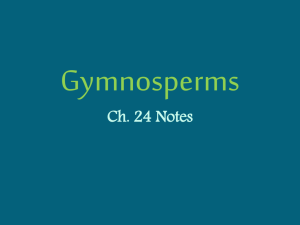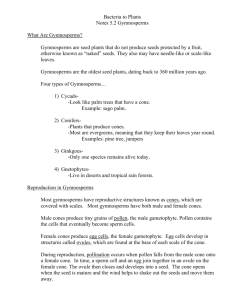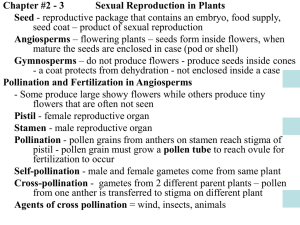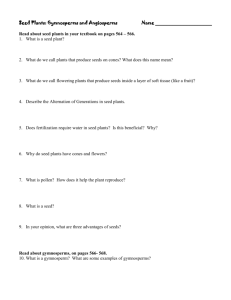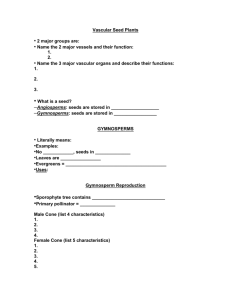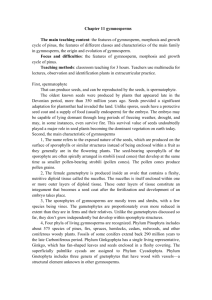Principles of Biology Lake Tahoe Community
advertisement
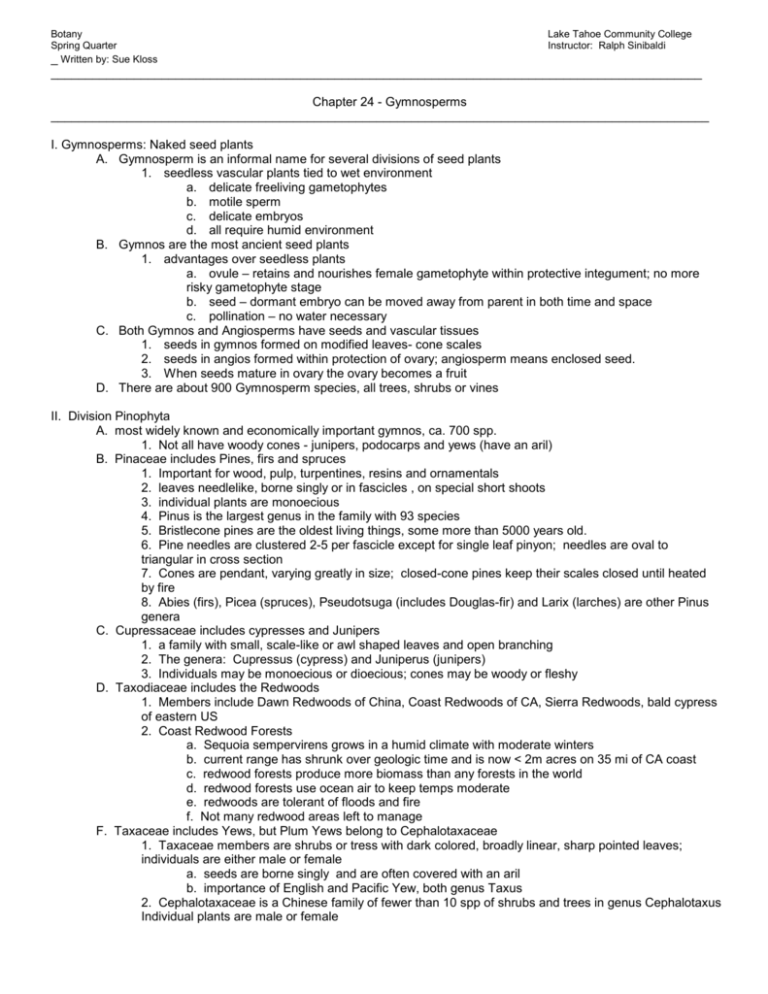
Botany Spring Quarter _ Written by: Sue Kloss Lake Tahoe Community College Instructor: Ralph Sinibaldi ______________________________________________________________________________________________ Chapter 24 - Gymnosperms _______________________________________________________________________________________________ I. Gymnosperms: Naked seed plants A. Gymnosperm is an informal name for several divisions of seed plants 1. seedless vascular plants tied to wet environment a. delicate freeliving gametophytes b. motile sperm c. delicate embryos d. all require humid environment B. Gymnos are the most ancient seed plants 1. advantages over seedless plants a. ovule – retains and nourishes female gametophyte within protective integument; no more risky gametophyte stage b. seed – dormant embryo can be moved away from parent in both time and space c. pollination – no water necessary C. Both Gymnos and Angiosperms have seeds and vascular tissues 1. seeds in gymnos formed on modified leaves- cone scales 2. seeds in angios formed within protection of ovary; angiosperm means enclosed seed. 3. When seeds mature in ovary the ovary becomes a fruit D. There are about 900 Gymnosperm species, all trees, shrubs or vines II. Division Pinophyta A. most widely known and economically important gymnos, ca. 700 spp. 1. Not all have woody cones - junipers, podocarps and yews (have an aril) B. Pinaceae includes Pines, firs and spruces 1. Important for wood, pulp, turpentines, resins and ornamentals 2. leaves needlelike, borne singly or in fascicles , on special short shoots 3. individual plants are monoecious 4. Pinus is the largest genus in the family with 93 species 5. Bristlecone pines are the oldest living things, some more than 5000 years old. 6. Pine needles are clustered 2-5 per fascicle except for single leaf pinyon; needles are oval to triangular in cross section 7. Cones are pendant, varying greatly in size; closed-cone pines keep their scales closed until heated by fire 8. Abies (firs), Picea (spruces), Pseudotsuga (includes Douglas-fir) and Larix (larches) are other Pinus genera C. Cupressaceae includes cypresses and Junipers 1. a family with small, scale-like or awl shaped leaves and open branching 2. The genera: Cupressus (cypress) and Juniperus (junipers) 3. Individuals may be monoecious or dioecious; cones may be woody or fleshy D. Taxodiaceae includes the Redwoods 1. Members include Dawn Redwoods of China, Coast Redwoods of CA, Sierra Redwoods, bald cypress of eastern US 2. Coast Redwood Forests a. Sequoia sempervirens grows in a humid climate with moderate winters b. current range has shrunk over geologic time and is now < 2m acres on 35 mi of CA coast c. redwood forests produce more biomass than any forests in the world d. redwood forests use ocean air to keep temps moderate e. redwoods are tolerant of floods and fire f. Not many redwood areas left to manage F. Taxaceae includes Yews, but Plum Yews belong to Cephalotaxaceae 1. Taxaceae members are shrubs or tress with dark colored, broadly linear, sharp pointed leaves; individuals are either male or female a. seeds are borne singly and are often covered with an aril b. importance of English and Pacific Yew, both genus Taxus 2. Cephalotaxaceae is a Chinese family of fewer than 10 spp of shrubs and trees in genus Cephalotaxus Individual plants are male or female G. Podocarpaceae and Auricariaceae are largely southern hemisphere families III. Vascular system of Conifers A. Conifers have secondary xylem and phloem, rays, wood with annual rings, and bark; due to the lack of vessels, conifer wood is very regular B. Tracheids produced in the spring have largest diameters, smaller in summer C. Some tracheids are so thick they are called fiber-tracheids 1. See fig 6.18 – three views of sections of wood D. Xylem rays are only one cell wide, composed of brick-shaped parenchyma cells E. Axial parenchyma cells may run in vertical columns F. Resin accumulates and flows in long resin ducts, axial chambers are bounded by parenchyma cells G. Phloem of coast redwood and other gymnos contains sieve cells (without companion cells), fibers, ray parenchyma, and axial parenchyma H. Pine needles show many anatomical adaptations to aridity with thick cuticles, sunken stomata, a fibrous epidermis, closely packed mesophyll without intercellular air spaces and veins in the center of the leaf. IV. Life Cycle of Pines, abbreviated – see handout A. Two kinds of cones are produced 1. Male gametophytes are produced in male or staminate cones, a. 2 microsporangia form on undersurface of conescale 2. females produced in larger ovulate or seed cones, a. 2 megasporangia develop on upper surface of cone scale 3. alternation of generations = diploid vs haploid stages in life cycle B. Pollination replaces need for free water 1. In conifers, polination is the transfer of pollen from male to female cones; cross pollination is usual but in dioecious individuals, self-pollination is impossible 2. Pollination occurs when the female cone is about nine months old; a sticky pollination drop exudes from the micropyle (a small hole in the seed coat) to trap pollen grains 3. pollen causes a chem signal to travel to ovule, where pollen grains and liquid absorbed into the seed where they come to lie on the surface of the nucellus (nutritive material in seed) 4. pollen tube germinates, slowly developing an elongating pollen tube that grows thru nucellus toward egg 5. 2 of the last formed nuclei in pollen tube are sperm nuclei; the pollen tube with the sperm nuclei and several vegetative nuclei are the mature male gametophyte 6. sperm nuclei, with pollen tube contents, are discharged directly around the egg C. Fertilization leads to seed formation 1. Fertilized egg becomes a diploid zygote, begins to divide immediately 2. A mature embryo has several cotyledons, an epicotyl, a hypocotyl and a radicle 3. female gametophyte grows by digesting the nucellus 4. integument hardens and becomes a seed coat, micropyle closes 5. when seeds are mature, cone scales open and seeds fall out; pine seed coats usually have an outgrowth, the wing, that aids in dispersal a. seeds contain dormant embryo, stored food and protective coat b. stratification used to break dormancy c. when seeds germinate, radicle emerges first; hypocotyl elongates, taking cotyledons and epicotyl above the surface while still enclosed in seed coat d. Cotyledons absorb nutrients stored in female gametophyte and then enlarge, pulling themselves out of seed coat e. cotyledons turn green in light and become photosynthetic and are eventually shed; true leaves are small and fewer in number V. Other gymnosperm divisions A. Cycadophyta Plants have palmlike traits 1. In early Mesozoic era, Cycads made up most of earth’s vegetation; trees are palm-like in appearance B. Ginkophyta has only one living species 1. Ginko biloba is only living representative C. Gnetophyta Plants are intermediate btn. gymnosperms and angiosperms 1. 3 genera: Ephedra, Gnetum and Welwitschia VI. Ecological and Economic importance of gymnosperms A. North American ecosystems are created largely by conifers B. major source of lumber, paper pulp, turpentine, and resins, and used as fuel for heat; they are widely used in Landscaping Lesson Objectives Ch. 24 – Gymnosperms 1. 2. 3. 4. 5. 6. 7. 8. Explain how seeds and pollen tubes provided advantages in adaptation to life on land. Why do most seed plants have nonflagellated sperm? Draw a very simple, general life cycle using the handout from class to alternation of generations in a gymnosperm. Describe production of sperm and eggs in a pine tree. How does fertilization take place? Describe general characteristics of 4 divisions of gymnosperm plants. Describe general characteristics of 5 families in the Pinophyta division. Describe prominent features in the vascular features of conifers. Describe some of the ecological and economic importance of gymnosperms.

